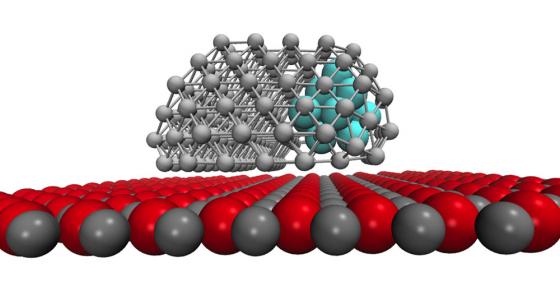Our group deals with the computational study of hard and soft matter at the nanoscale
Interaction between synthetic nanomaterials and biological membranes
The last two decades have been characterized by an extraordinary growth in the production and commercialization of nano-sized materials. Carbon, metal and polymer nanoparticles offer unprecedented opportunities in many fields of technology, ranging from catalysis to biomedicine. Yet, their production and use might also imply some environmental and biological risks. One of the most relevant processes for the toxicity of nanomaterials is their interaction with cell membranes. Biological membranes are the first barrier encountered by any particle entering an organism. The interaction of nanoparticles with biological membranes is therefore of paramount importance to understand the molecular basis of the biological effects of nanomaterials.
A multiscale computational approach, based on atomistic or coarse-grained models, can shed light on the molecular mechanisms of interaction between synthetic nanomaterials and biological membranes. Our research group, in collaboration with the group of Luca Monticelli (INSERM/CNRS, Lyon), studies the interaction between plastic or metal nanoparticles and model lipid membranes.

Metal nanoalloys: structure, thermodynamics and kinetics
Nanoalloys are nanometer-sizes metal nanoparticles composed by two or more metal species. Nanoalloy properties, catalytic and optical in particular, make them interesting for a variety of applications, ranging from the development of efficient and low-cost catalyzers to the production of light-responsive coatings. Nanoalloy properties are driven by the atomic structure and chemical ordering of the metal components. We investigate the structural and chemical properties of nanoalloys by means of Global Optimization tools, and we study their thermodynamic behavior via Molecular Dynamics and enhanced sampling techniques.

Aggregation of colloidal nanoparticles
Ceramic materials are obtained via precipitation of colloidal suspension. The process leads to the formation of disordered, highly porous gels or to the sedimentation of crystalline grains, depending on the experimental conditions. We model, by means of brownian dynamics and stochastic rotation dynamics, the aggregation process in binary colloidal system with the aim to identify the conditions leading to the formation of ordered, stable colloidal crystals. By means of advanced sampling techniches such as Metadynamics, we are able to study the mechanisms of solid-solid transitions in colloidal crystals.




